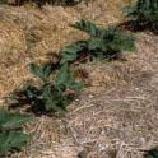Unused stories
Want to Reduce Your Water Bill and Weeds at the Same Time?

It’s often said that you can’t get too much of a good thing. If you’re talking about mulch, most gardeners are more than willing to give you an earful about the virtues of the stuff. It is one of the easiest and least expensive things you can do in the garden that provides a plethora of benefits. By simply adding a layer of mulch to the soil in the spring, you can moderate soil temperature, reduce water consumption, add nutrients to the soil, reduce erosion, encourage earthworm activity, reduce weeds, improve the garden’s appearance, save time and save money. Dollar for dollar, that’s a pretty good return on your investment!
Mulch is basically a protective blanket placed over the soil and can be either an organic or inorganic material. Organic mulches like compost, grass clippings, tree leaves and wood chips, decompose over time; inorganic mulches (e.g., gravel) generally don’t break down thus don’t have to be replaced as frequently. When deciding on what to use, choose a material that doesn’t affect soil pH significantly or deplete valuable minerals as it decomposes, doesn’t reflect so much light that it produces heat that can damage plants, or present any inherent risk for poisoning or flammability.
Mid- to late spring (after the heavy rains have stopped) is a good time to add your mulch. The amount of mulch you use depends on the texture and density of the material you’re adding and the quality of drainage of the soil your covering. A good rule of thumb is to add two to four inches of mulch; much more than this, or “too much of a good thing” and you may restrict air and water movement that can result in “mulch toxicity” where anaerobic (without air) conditions are created. Remove weeds, and then carefully spread an even layer of mulch, keeping it a few inches from the base of the plant or the trunk of a tree.
